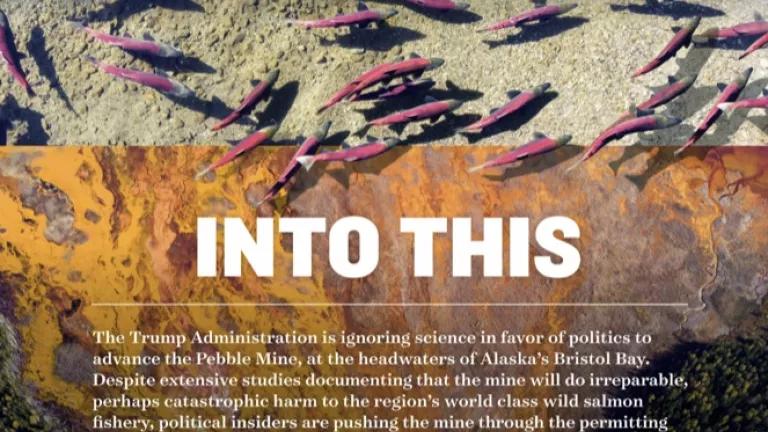Pebble Mine Foes Run Ads Before Congressional Hearing

Opponents of the Pebble Mine ran a full-page ad today in Politico, calling on Congress to protect Bristol Bay from the political corruption that is currently fast-tracking the gold and copper mining project.
The mine, proposed for the headwaters of Bristol Bay, Alaska, would have disastrous social, environmental and economic impacts.
A House Transportation and Infrastructure subcommittee holds a hearing Wednesday on the Pebble Mine.
Bristol Bay is an American treasure and economic engine. Home to the world’s greatest wild salmon fishery, it generates $1.5 billion annually, fuels Alaska’s economy, supports 14,000 jobs, and feeds indigenous communities. The proposed Pebble Mine threatens the entire region—its people, water, fisheries, and wildlife.
The hearing will focus on the Trump administration’s prioritization of politics over science and its reckless draft Environmental Impact Statement (EIS) for the Pebble Mine. The Army Corps of Engineers’ draft EIS disregards science, excludes public opinion and fails entirely to properly evaluate the risks of the mine to water quality, fish, wildlife, and subsistence communities.
The Trump administration has widely rejected its own draft EIS:
- The Department of the Interior called it “so inadequate that it precludes meaningful analysis” and urged that a “revised or supplemental [review] be prepared to resolve significant gaps in the document.”
- The Environmental Protection Agency concluded that the draft EIS likely “underpredicts” the mine’s potential impacts on water quality, salmon, and air quality and does not “support a reasonable judgment” that the project will comply with the Clean Water Act. EPA found that the Pebble Mine may have “substantial and unacceptable adverse impacts” on fisheries in Bristol Bay.
- The U.S. Fish and Wildlife Service said that, “the project as proposed will have significant adverse impacts on important, fish, wildlife, and aquatic habitats…[W]e recommend that a permit not be issued for the project as currently proposed.”
Most recently, Alaska Senator Lisa Murkowski, chairwoman of the Senate Interior and Environment Appropriations Subcommittee, inserted language in the federal spending bill that calls for the Army Corps to address gaps and deficiencies in the draft EIS and encouraged the EPA to exercise “discretionary authorities,” including its power under the Clean Water Act, if still unsatisfied with the Army Corps’ assessment.
Trump’s EPA recently withdrew Obama-era proposed restrictions on the mine. A host of groups, including NRDC, are suing.
We’re also urging the Army Corps to immediately abandon its reckless approach to permitting:
- First, the Army Corps’ rush to permit the mine is wholly inconsistent with a project of this scale, where the impacted communities are geographically dispersed, and its environmental impacts are highly complex.
- Second, the draft EIS lacks important detail, substantive information and environmental baseline data. Without this critical information, it is impossible for the Army Corps and the public to fully analyze the impacts of the proposed project, precluding meaningful public participation. The DEIS fails to appropriately address substantive risks which are at the core of scientific and public concern about the project including the risk of large-scale catastrophic tailings dam failure and risks posed to river water quality by contaminated groundwater seepage.
- Finally, Pebble has failed to provide any information about the economic viability of the project. This is the largest mine ever proposed in Alaska, yet Pebble has not yet published even a preliminary feasibility study for the mine design. Pebble has less than $20 million in cash. That is not nearly enough to meet its upcoming obligations, let alone finish the permitting process or build the mine.
The sheer scope and impacts of the Pebble Project are staggering: the 1.4 billion ton, 20-year mine would permanently destroy more than 3,500 acres of wetlands and 80 miles of streams. Touted by the Pebble Partnership as a “small” mine plan because it would only extract 1/8th of the entire deposit, it is clear that the company intends, and its shareholders expect, this to be a multi-stage, multi-generational mining project at the headwaters of the Bristol Bay watershed. This proposal is just the first stage.
A scientific assessment by the EPA in 2014, conducted over three years and twice-peer reviewed, irrefutably demonstrated that a mine much smaller than what is currently proposed would have significant and potentially catastrophic impacts on the Bristol Bay watershed.
As the ad says:
It’s time to listen to the science and stand with the people of Bristol Bay in their fight to stop the Pebble Mine.
